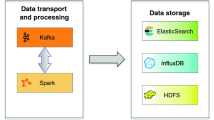Abstract
IMPCAS has constructed and currently manages a large number of accelerator facilities. However, the current accelerator monitoring methods are unable to satisfy all of the device requirements. The accelerator control monitoring system (ACMS) was created and established to provide an efficient and accurate accelerator control monitoring system. It enables automatic alerting of problems with accelerator control systems and infrastructure. It utilizes a big data distributed stream processing engine and open-source monitoring tools. Metrics, logs, and EPICS PV values are the major three types of data that it monitors. Prometheus is primarily used to monitor metrics such as network traffic, hardware devices, and software operations. Graylog is used to monitor logs created by various applications and systems. We also created the EPICS Pulsar connector software, which allows us to transfer PV values to the Pulsar messaging cluster and use the Flink compute engine for real-time monitoring. The designed data management module allows users to define alert rules in a variety of ways. The ACMS enables the separation of the Flink business system and alarm rules. Users may use the data management module to add or alter alarm rules in real-time without having to restart the alarm software. This reduces the effect of alarm flooding when the accelerator reaches the beam shifting or shutdown condition and dramatically enhances alarm efficiency. The main components of the ACMS may be deployed in clusters, making it extremely versatile. Experimental results demonstrated that it has a higher throughput than the Phoebus Alarm system and can handle millions of monitoring indicators. The ACMS employs a modular framework that is very scalable. Long-term stability analyses were performed at the SESRI and HIRFL facilities. It achieved all of the intended goals and could greatly improve the accident handling efficiency while minimizing the failure time of the accelerator control system.













Similar content being viewed by others
Data availability
The data that support the findings of this study are openly available in Science Data Bank at https://doi.org/10.57760/sciencedb.j00186.00059 and https://cstr.cn/31253.11.sciencedb.j00186.00059.
References
F. Locci, F. Ehm, L. Gallerani et al., CERN controls open source monitoring system. in 17th international conference on accelerator and large experimental physics control systems (ICALEPCS’19), (New York, 2019), pp 404–408. https://doi.org/10.18429/JACoW-ICALEPCS2019-MOPHA085
S. Sasaki, T. T. Nakamura, and M. Hirose. Monitoring system for IT infrastructure and EPICS control system at SuperKEKB. in 17th international conference on accelerator and large experimental physics control systems (ICALEPCS’19), (New York, USA, 2019), pp. 05–11. doi:https://doi.org/10.18429/JACoW-ICALEPCS2019-WEPHA134
Alarm Handler. (2022) https://epics.anl.gov/extensions/alh/index.php. Accessed 31 Oct 2022
Control System Studio. https://controlsystemstudio.org/;2022. Accessed 31 Oct 2022
Elasticsearch. https://www.elastic.co/cn/;2022. Accessed 31 Oct 2022
S. Xu, G.F. Liu, Y.F. Gan et al., The development of the alarm system for HLS-II. J. Instrum. 17, 06027 (2022). https://doi.org/10.1088/1748-0221/17/06/p06027
J.C. Yang, J.W. Xia, G.Q. Xiao et al., High intensity heavy ion accelerator facility (HIAF) in China. Nucl. Instrum. Methods Phys. Res. Sect. B. 317, 263–265 (2013). https://doi.org/10.1016/j.nimb.2013.08.046
M.T. Tang, L.J. Mao, H.J. Lu et al., Design of an efficient collector for the HIAF electron cooling system. Nucl. Sci. Tech. 32, 116 (2021). https://doi.org/10.1007/s41365-021-00949-0
Experimental Physics and Industrial Control System. (2022) https://epics-controls.org/. Accessed 13 Nov 2022
Y.B. Yan, Y.B. Leng, D.K. Liu et al., EPICS interface to libera electron beam position monitor. Nucl. Sci. Tech. 19, 65–69 (2008). https://doi.org/10.1016/S1001-8042(08)60024-X
Y.F. Song, C. Li, K. Xuan et al., Automatic data archiving and visualization at HLS-II. Nucl. Sci. Tech. 29, 129 (2018). https://doi.org/10.1007/s41365-018-0461-6
Prometheus. https://prometheus.io/;2022. Accessed 13 Nov 2022
Graylog. https://www.graylog.org/;2022. Accessed 13 Nov 2022
Apache Pulsar. https://pulsar.apache.org/;2022. Accessed 16 Nov 2022
Apache Flink. https://flink.apache.org/;2022. Accessed 16 Nov 2022
MySQL. https://www.mysql.com/;2022. Accessed 16 Nov 2022
InfluxDB. https://www.influxdata.com/products/influxdb-overview/;2022. Accessed 16 Nov 2022
Grafana. https://grafana.com/;2022. Accessed 17 Nov 2022
H3C Comware MIB. (2022) http://www.h3c.com/cn/d_201806/1089291_473262_0.htm. Accessed 17 Nov 2022
K. Moriyama, T. Nakatani, Y. Yasu et al. Development of status analysis system based on ELK stack at J-PARC MLF, in 16th international conference on accelerator and large experimental physics control systems (ICALEPCS’17), (Barcelona, Spain, 2017), pp. 8–13. doi:https://doi.org/10.18429/JACoW-ICALEPCS2017-THPHA033
MongoDB. https://www.mongodb.com/;2022. Accessed 16 Nov 2022
C. Yuan, W. Zhang, M. Yue et al., The design of accelerator control network analysis system and its application. Radiat. Detect. Technol. Methods. (2022). https://doi.org/10.1007/s41605-022-00372-y
Openmessaging benchmark. https://openmessaging.cloud/docs/benchmarks/;2022. Accessed 21 Nov 2022
Author information
Authors and Affiliations
Contributions
All authors contributed to the study conception and design. Interface design was performed by Tao Ma and Peng-Peng Wang; Algorithm implementation and experimental analysis were performed by Chao Yuan and Tao Ma; Investigation and project administration were performed by Wei Zhang. The first draft of the manuscript was written by Chao Yuan and Min Yue. And all authors commented on previous versions of the manuscript. All authors read and approved the final manuscript.
Corresponding author
Ethics declarations
Ethical approval
The ACMS was designed for large accelerator device such as High Intensity Heavy-ion Accelerator Facility (HIAF). To verify our design, we deployed and tested all functions on existing accelerators, Heavy Ion Research Facility in Lanzhou (HIRFL) accelerator and Space Environment Simulation and Research Infrastructure (SESRI) accelerator.
Rights and permissions
Springer Nature or its licensor (e.g. a society or other partner) holds exclusive rights to this article under a publishing agreement with the author(s) or other rightsholder(s); author self-archiving of the accepted manuscript version of this article is solely governed by the terms of such publishing agreement and applicable law.
About this article
Cite this article
Yuan, C., Zhang, W., Ma, T. et al. Design and implementation of accelerator control monitoring system. NUCL SCI TECH 34, 56 (2023). https://doi.org/10.1007/s41365-023-01209-z
Received:
Revised:
Accepted:
Published:
DOI: https://doi.org/10.1007/s41365-023-01209-z




